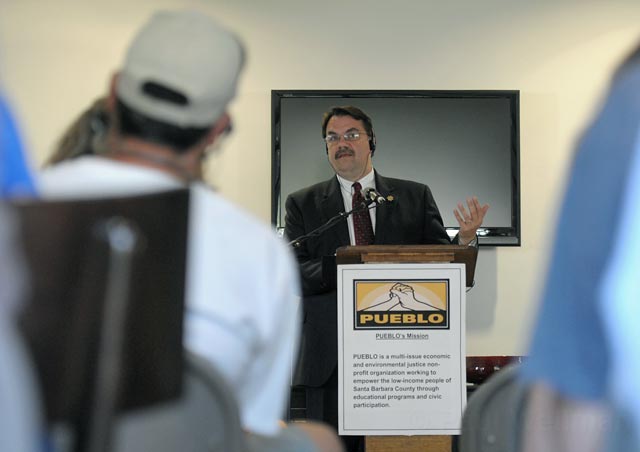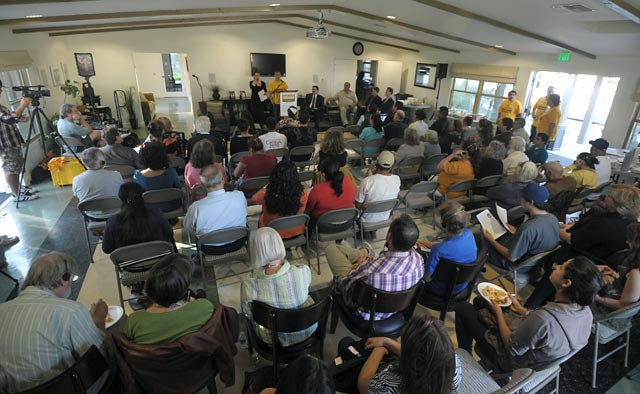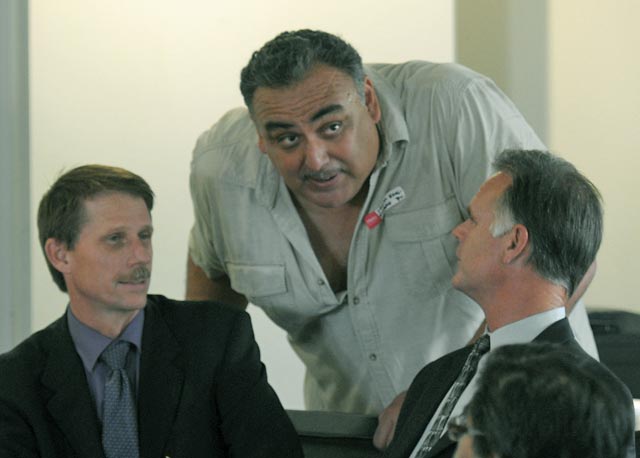Sheriff Addresses Deportation Program Concerns
Distances His Department from Immigration and Customs Enforcement Initiative

Sheriff Bill Brown was the featured speaker at a forum sponsored by social justice group PUEBLO Thursday evening, talking about the controversial federal Secure Communities program — designed to deport the most serious criminal illegal immigrants — and its implementation and effect in Santa Barbara County.
“It’s very important we have this kind of dialogue,” Brown told the crowd of about 75 people before taking time to explain the Immigration and Customs Enforcement (ICE) program. The Sheriff’s Department had nothing to do with its development, Brown said, adding ICE didn’t do itself any favors with the way it was rolled out and explained — or not explained — to the public. His hope, he told the crowd, is that “it’s a program that does what it’s designed to do,” that is, take criminal illegal immigrants off the streets.

The forum came just a day after ICE announced the arrests of 2,901 criminal immigrants across all 50 states. According to some reports, nine of those arrests took place in Santa Barbara County.
Brown explained the Sheriff’s Department takes the fingerprints of everyone booked into Santa Barbara County Jail. Historically, those fingerprints were automatically sent to the FBI and, after Secure Communities began, are now sent to ICE. Those fingerprints are checked against criminal databases and ICE databases. If ICE officials ask the department to hold an inmate, they do, Brown said. ICE officials visit the jail two to three times a week, and take it from there.
The issue opponents have with the program, however, is that it doesn’t really get rid of the most violent criminals, and they point to statistics which seem to show a large number of low level offenders — or non-offenders — being snagged.
According to ICE, nearly 48,000 convicted criminal aliens have been identified in California as a result of the program, and nearly 24,000 deported. Of those, however, only 10,000 were serious or violent offenders. Recent statistics show Santa Barbara County has one of the highest deportation rates of noncriminals at 58 percent, based on data beginning January 2010 — when Secure Communities was enacted — through July 2010. And according to data obtained from ICE by a coalition of groups that includes the Center for Constitutional Rights, 79 percent of the people deported were noncriminals or had lower-level offenses, such as traffic infractions or petty juvenile mischief convictions.

The sheriff said he has heard anecdotal stories, but couldn’t point to any specific case where a person not guilty of a crime had actually been deported. He also said “noncriminal” can often be a misnomer. A person could have very well committed a crime, he said, but for one reason or another, their case wasn’t adjudicated. He also noted that ICE has a revamped strategy to go after Level 1 offenders — the worst of the worst.
After Brown faced a series of questions, he listened to testimonials from two people in the crowd. They spoke not about Secure Communities, but about interactions between area law enforcement and the Latino community. One man brought up the impounding policies in place when a person is found not to have a license while driving a car. Brown said that giving someone a 20 to 30 minute window to come pick up the car to avoid impounding could lead to people speeding to get there on time. The man also addressed DUI checkpoints. They often end up towing more cars of people without licenses than for driving under the influence, he said. Brown noted there was legislation on the governor’s desk which could possibly address both those issues — it was just a matter of the bills being signed into law.
While only two people spoke publicly, PUEBLO director Mark Alvarado pointed out that the majority of unasked questions and testimonials written on note cards were geared toward police treatment of Latinos. “Where there’s smoke, there’s fire,” he said.
Afterword, Alvarado said the meeting was a positive start, but, “We’re still not where we need to be in trying to convince elected officials [Secure Communities] is not a good program for our community.” Still, he said, the forum was a good opening dialogue, and one he hopes to emulate in the future, providing the opportunity for a community, often underrepresented, to make its voice heard.



